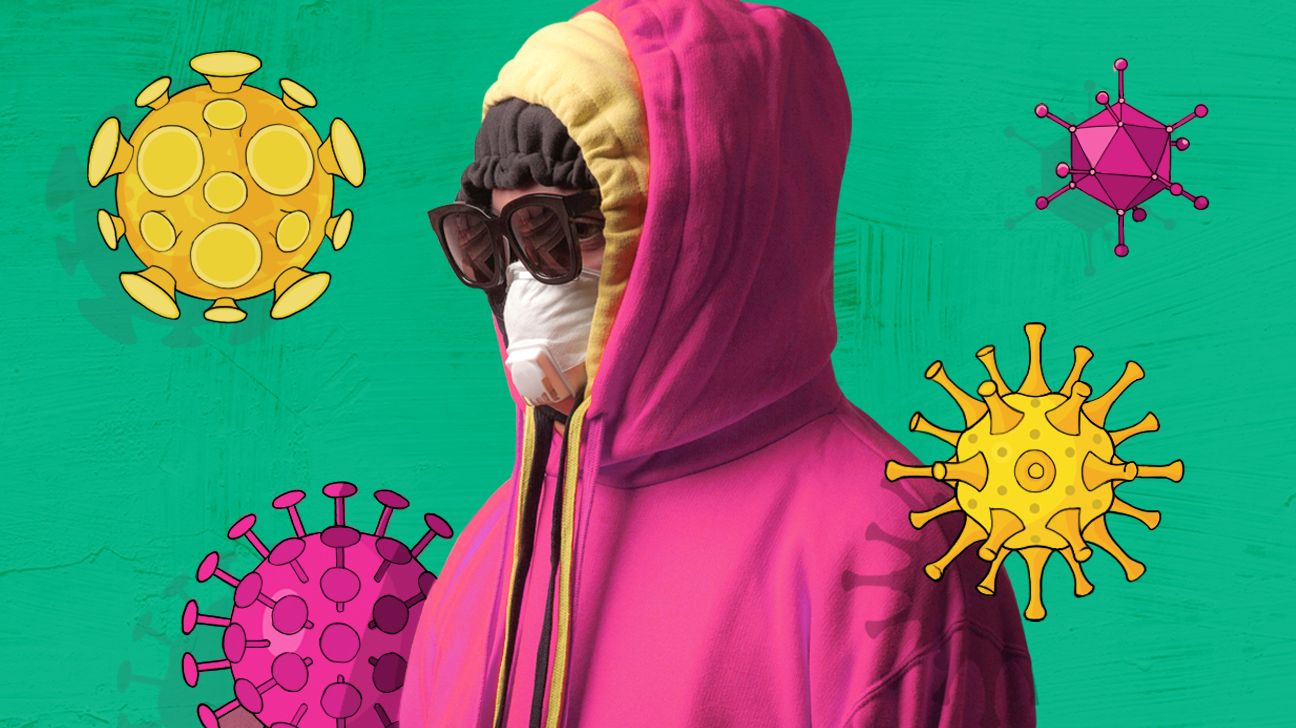Ugh, allergies… Those of you in-the-know know what we’re talking about. Certain times of the year tickle your throat or make your nose leak. Typically, a cough or an achoooo in March means pollen is to blame. But in pandemic times, all bets are off. It could be allergies — or something else.
Just about any respiratory symptom now makes us stop and run through the possibilities. Omg! Is it… the new coronavirus? Cue the ominous music.
COVID-19, the flu, colds, and of course good ol’ allergies all have some symptoms in common. So, it can be tricky to tell. Let’s break it down.

This handy-dandy table compiled using info from the Centers for Disease Control and Prevention (CDC) might be your first stop when it comes to sussing out the source of your symptoms.
But as you can see, some symptoms are common across the board. So, read on for more specifics.
| Symptoms | COVID-19 | Flu | Cold | Allergies |
| fever/chills | √ | √ | Rarely | |
| cough | √ | √ | √ | √ |
| shortness of breath | √ | √ | √ | |
| fatigue | √ | √ | √ | |
| muscle or body aches | √ | √ | ||
| headache | √ | √ | √ | √ |
| new loss of taste/smell | √ | |||
| sore throat | √ | √ | √ | √ |
| congestion/runny nose | √ | √ | √ | √ |
| sneezing | √ | √ | ||
| post-nasal drip | √ | √ | ||
| watery eyes | √ | √ | ||
| nausea/vomiting | √ | More common in children | ||
| diarrhea | √ | More common in children |
If you do have a respiratory illness, and you’re waffling between whether it’s the flu or COVID-19, the CDC recommends testing for both.
But if you can only get tested for one for whatever reason, it’s best to get a ruling on COVID-19 one way or the other. For one thing, if you are positive for COVID-19, it can help to have the results just in case you have complications, lingering symptoms, or any long-hauler symptoms that crop up.
But also, COVID-19 is the more infectious of the two. So, if you have it, you’ll need to stay home and keep clear of others, according to the CDC for at least 10 days from when your symptoms first appeared, and from there, at least 24 hours after your fever subsides without the use of fever-reducing meds. Your other symptoms should also be improving before you venture out.
According to the CDC, if it’s the flu, your healthcare provider may prescribe antiviral drugs to ease your symptoms. When you have the flu, you should stay home as much as possible to avoid transmitting an infection. The CDC says you can head out again 24 hours after your fever takes a hike without the help of meds.
Let’s get the big guy out of the way first. Could it be COVID-19? First, ask yourself a few questions to gauge the possibility of developing it.
COVID-19 questions:
- Have you recently been exposed to anyone who has tested positive?
- Any chance someone you live with has been around someone who has recently tested positive?
- Have you recently been around others you don’t live with, and in a situation where people weren’t physically distanced or weren’t wearing masks?
- Any travel on a plane, train, bus, or public transit?
- Have you recently been inside a restaurant or bar?
If you’ve answered yes to any of these questions, then COVID-19 is a possibility. But a yes answer doesn’t automatically mean you have the new coronavirus. If you answered no to all questions, that doesn’t fully eliminate the potential for developing the new coronavirus, but it makes COVID-19 less likely.
Consider your symptoms. Do you have a fever or chills or a cough? A research review showed that these symptoms are some of the first to show up with COVID-19. But they’re also common with ye ol’ flu.
Although they are entirely different respiratory bad boys, COVID-19 and the flu do share most of their common symptoms. The big standout difference, according to the CDC, is the whole loss of taste or smell thing we’ve been hearing about. Those symptoms are unique to COVID-19. So, if you suddenly can’t taste the kimchi kick in your ramen, it’s possible COVID-19 is the culprit.
Also, consider whether you have gastrointestinal symptoms like vomiting or diarrhea. Although, GI symptoms can be a part of the flu, they’re more common in kids than adults. GI symptoms are commonly reported with COVID-19 across age groups, though not always.
Keep in mind that flu rates are down this year in most states, like waaay down. That’s likely a result of all the mask-wearing, hand-washing, and physical distancing we’ve been doing. Go us!
Did you get your flu shot? A flu shot is not a guarantee that you won’t get the flu, but according to the CDC, it typically offers some protection from developing an infection, and from severe symptoms if you do develop an infection. So, if you did get jabbed, but you’re awfully ill, that might be another reason to suspect COVID-19 rather than the flu.
A big difference between a cold and the flu is that cold symptoms usually come on gradually, according to the CDC, whereas the flu hits more like a truck, taking you down all at once.
Although a fever sometimes happens with a cold, it’s a rarer symptom. And same with a headache or body aches. These ailments are less likely to occur with a cold than they are with the flu or COVID-19. And you might feel a little more rundown when you have a cold, but if you have the flu or symptomatic COVID-19, people often feel downright tired or fatigued. And a cold shouldn’t give you any GI symptoms.
Now let’s talk about snot. I know, hot right? With a cold, you’re likely to be sneezy, sniffly, stuffy, runny, or have post-nasal drip — that’s when the snot runs down the back of your throat. Mmm. With the flu, you could certainly have nasal congestion, but you’re not likely to be a sneezy mess. A plugged nose can certainly make breathing less fun, but a cold shouldn’t leave you short of breath. But the flu or COVID-19 might.
You may already know you’re prone to seasonal outdoor allergies. But keep in mind that indoor allergies are also a thing and pretty common in winter, according to the American Academy of Allergy, Asthma & Immunology. So, if you’ve been snug as a bug in a rug, it could literally be all those bugs (dust mites) in the rugs causing you to sneeze. And if you’ve recently moved, you could be exposed to new triggers outdoors that suddenly bring on an undiagnosed allergy.
Allergies can also cause shortness of breath, especially if you have the winning combination that I do which is allergies and asthma. Oh, joy! Although allergic rhinitis is often called hay fever, a fever isn’t actually a classic symptom, according to the CDC. Neither are body aches nor GI symptoms.
But you might get an irritated throat if you’re plagued by post-nasal drip, and you could feel fatigued, especially if you’ve taken an antihistamine to combat sneezing or itching.
How do you know the difference between a cold and allergies since they can have similar symptoms? Allergies will come on suddenly as a result of exposure to a trigger, whereas a cold usually comes on gradually. If you are suddenly having a sneeze fest one morning, check the pollen count on your favorite weather app. That could offer at least a hint.
Trying to play the guessing game of whether it’s COVID-19, the flu, the common cold, or allergies can be complicated. If there’s a chance you’ve been exposed to the new coronavirus, it’s a good idea to get tested, so you know for sure.

